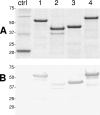Ehrlichia canis gp200 contains dominant species-specific antibody epitopes in terminal acidic domains
- PMID: 17682040
- PMCID: PMC2044547
- DOI: 10.1128/IAI.00041-07
Ehrlichia canis gp200 contains dominant species-specific antibody epitopes in terminal acidic domains
Abstract
Species-specific antibody epitopes within several major immunoreactive protein orthologs of Ehrlichia species have recently been identified and molecularly characterized. In this study, dominant B-cell epitopes within the acidic (pI 5.35) ankyrin repeat-containing 200-kDa major immunoreactive protein (gp200) of Ehrlichia canis were defined. The E. canis gp200 gene (4,263 bp; 1,421 amino acids) was cloned and expressed as four (N-terminal, 1,107 bp; N-internal, 910 bp; C-internal, 1,000 bp; and C-terminal, 1,280 bp) overlapping recombinant proteins. The N-terminal, C-internal, and C-terminal polypeptides (369, 332, and 426 amino acids, respectively) were strongly recognized by antibody, and the major epitope(s) in these polypeptides was mapped to four polypeptide regions (40 to 70 amino acids). Smaller overlapping recombinant polypeptides (14 to 15 amino acids) spanning these regions identified five strongly immunoreactive species-specific epitopes that exhibited conformational dependence. The majority of the epitopes (four) were located in two strongly acidic (pI 4 to 4.9) domains in the distal N- and C-terminal regions of the protein flanking the centralized ankyrin domain-containing region. The amino acid content of the epitope-containing domains included a high proportion of strongly acidic amino acids (glutamate and aspartate), and these domains appear to have important biophysical properties that influence the antibody response to gp200.
Figures





Similar articles
-
Immunoreactive Protein Repertoires of Ehrlichia chaffeensis and E. canis Reveal the Dominance of Hypothetical Proteins and Conformation-Dependent Antibody Epitopes.Infect Immun. 2021 Oct 15;89(11):e0022421. doi: 10.1128/IAI.00224-21. Epub 2021 Aug 2. Infect Immun. 2021. PMID: 34370510 Free PMC article.
-
Tyrosine-phosphorylated Ehrlichia chaffeensis and Ehrlichia canis tandem repeat orthologs contain a major continuous cross-reactive antibody epitope in lysine-rich repeats.Infect Immun. 2011 Aug;79(8):3178-87. doi: 10.1128/IAI.01347-10. Epub 2011 May 23. Infect Immun. 2011. PMID: 21606187 Free PMC article.
-
Major species-specific antibody epitopes of the Ehrlichia chaffeensis p120 and E. canis p140 orthologs in surface-exposed tandem repeat regions.Clin Vaccine Immunol. 2009 Jul;16(7):982-90. doi: 10.1128/CVI.00048-09. Epub 2009 May 6. Clin Vaccine Immunol. 2009. PMID: 19420187 Free PMC article.
-
Differentially expressed and secreted major immunoreactive protein orthologs of Ehrlichia canis and E. chaffeensis elicit early antibody responses to epitopes on glycosylated tandem repeats.Infect Immun. 2006 Jan;74(1):711-20. doi: 10.1128/IAI.74.1.711-720.2006. Infect Immun. 2006. PMID: 16369028 Free PMC article.
-
Identification of a glycosylated Ehrlichia canis 19-kilodalton major immunoreactive protein with a species-specific serine-rich glycopeptide epitope.Infect Immun. 2007 Jan;75(1):74-82. doi: 10.1128/IAI.01494-06. Epub 2006 Nov 6. Infect Immun. 2007. PMID: 17088359 Free PMC article.
Cited by
-
Molecular characterization of antibody epitopes of Ehrlichia chaffeensis ankyrin protein 200 and tandem repeat protein 47 and evaluation of synthetic immunodeterminants for serodiagnosis of human monocytotropic ehrlichiosis.Clin Vaccine Immunol. 2010 Jan;17(1):87-97. doi: 10.1128/CVI.00331-09. Epub 2009 Dec 2. Clin Vaccine Immunol. 2010. PMID: 19955322 Free PMC article.
-
Immunoreactive Protein Repertoires of Ehrlichia chaffeensis and E. canis Reveal the Dominance of Hypothetical Proteins and Conformation-Dependent Antibody Epitopes.Infect Immun. 2021 Oct 15;89(11):e0022421. doi: 10.1128/IAI.00224-21. Epub 2021 Aug 2. Infect Immun. 2021. PMID: 34370510 Free PMC article.
-
Recombinant Ehrlichia P29 protein induces a protective immune response in a mouse model of ehrlichiosis.Vaccine. 2013 Dec 5;31(50):5960-7. doi: 10.1016/j.vaccine.2013.10.036. Epub 2013 Oct 19. Vaccine. 2013. PMID: 24144475 Free PMC article.
-
Sequence and phylogenetic analysis of the gp200 protein of Ehrlichia canis from dogs in Taiwan.J Vet Sci. 2010 Dec;11(4):333-40. doi: 10.4142/jvs.2010.11.4.333. J Vet Sci. 2010. PMID: 21113103 Free PMC article.
-
A variable-length PCR target protein of Ehrlichia chaffeensis contains major species-specific antibody epitopes in acidic serine-rich tandem repeats.Infect Immun. 2008 Apr;76(4):1572-80. doi: 10.1128/IAI.01466-07. Epub 2008 Jan 22. Infect Immun. 2008. PMID: 18212082 Free PMC article.
References
Publication types
MeSH terms
Substances
Grants and funding
LinkOut - more resources
Full Text Sources
Other Literature Sources
Research Materials
Miscellaneous

